Case Study: McDonald's Governance, Ethics, and Investment Decisions
VerifiedAdded on 2021/01/01
|18
|6278
|391
Case Study
AI Summary
This case study examines the corporate governance issues faced by McDonald's, focusing on incidents related to food quality and ethical concerns. The study analyzes various scenarios, including contaminated food incidents in South Korea, the use of beef oil in French fries, and health claims related to obesity. It explores the application of decision-making theory, business ethics theory, and Pica theory to address these issues. The analysis delves into corporate governance structures, risk management models, and the importance of stakeholder relations. The case study also investigates the potential for similar events in the UK, general lessons learned, and investment decisions related to the firm. The document provides a comprehensive overview of McDonald's challenges and potential solutions, offering valuable insights into governance, risk, and ethics within the fast-food industry. The case study also touches on the importance of risk management, identifying risks, analyzing their impact, and implementing corrective actions. The document also explores the issues around risk management and the application of corporate governance principles.
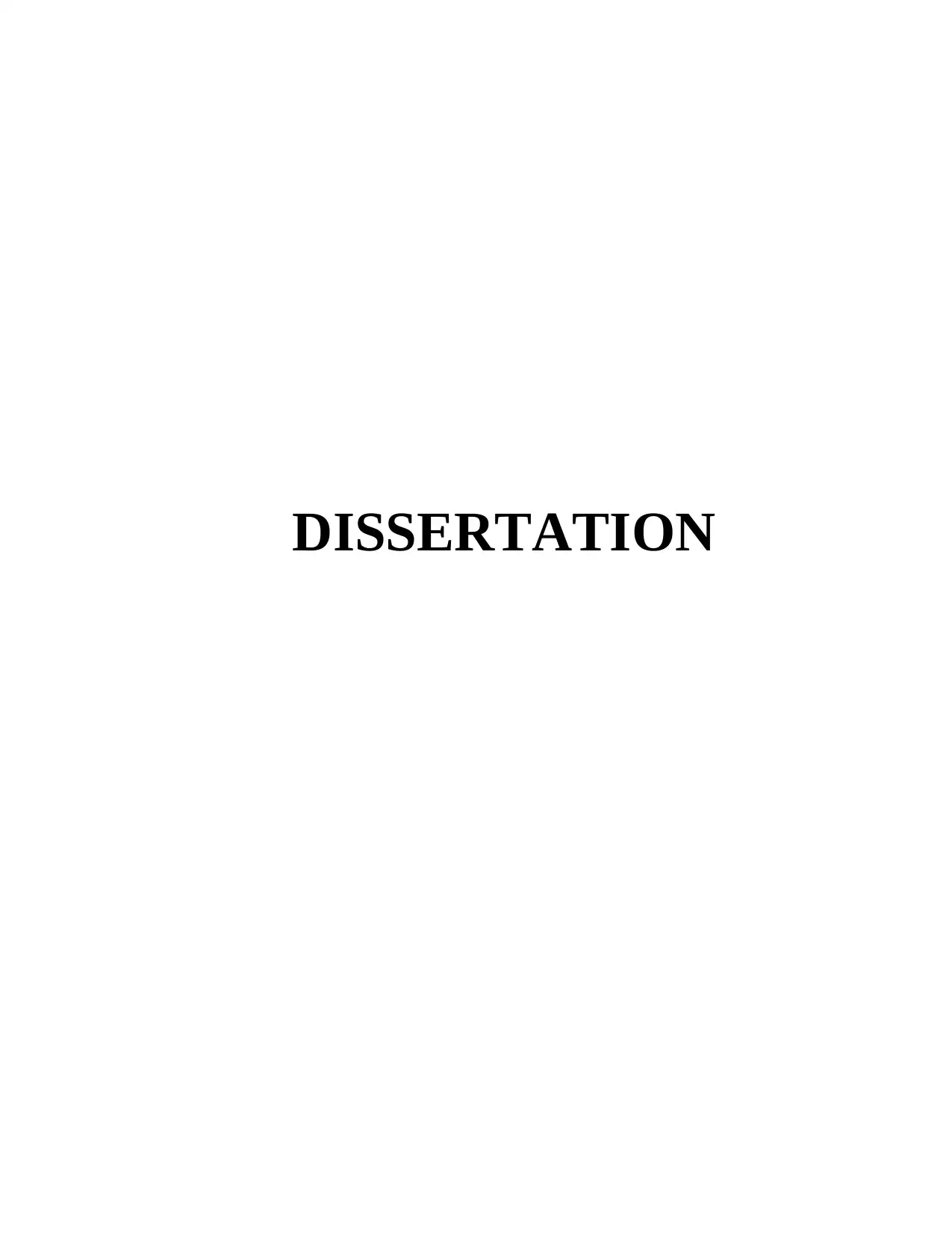
DISSERTATION
Paraphrase This Document
Need a fresh take? Get an instant paraphrase of this document with our AI Paraphraser
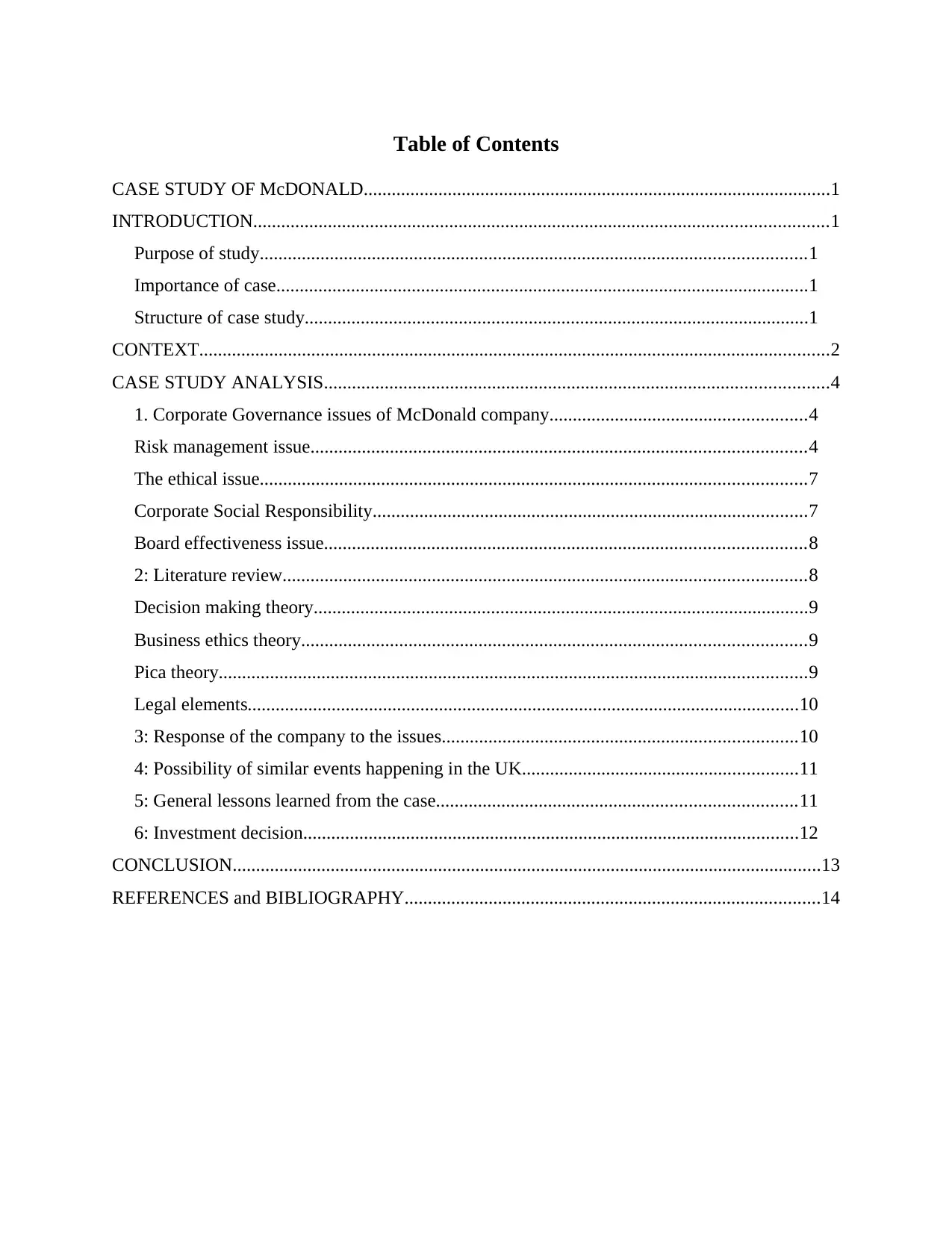
Table of Contents
CASE STUDY OF McDONALD....................................................................................................1
INTRODUCTION...........................................................................................................................1
Purpose of study.....................................................................................................................1
Importance of case..................................................................................................................1
Structure of case study............................................................................................................1
CONTEXT.......................................................................................................................................2
CASE STUDY ANALYSIS............................................................................................................4
1. Corporate Governance issues of McDonald company.......................................................4
Risk management issue..........................................................................................................4
The ethical issue.....................................................................................................................7
Corporate Social Responsibility.............................................................................................7
Board effectiveness issue.......................................................................................................8
2: Literature review................................................................................................................8
Decision making theory..........................................................................................................9
Business ethics theory............................................................................................................9
Pica theory..............................................................................................................................9
Legal elements......................................................................................................................10
3: Response of the company to the issues............................................................................10
4: Possibility of similar events happening in the UK...........................................................11
5: General lessons learned from the case.............................................................................11
6: Investment decision..........................................................................................................12
CONCLUSION..............................................................................................................................13
REFERENCES and BIBLIOGRAPHY.........................................................................................14
CASE STUDY OF McDONALD....................................................................................................1
INTRODUCTION...........................................................................................................................1
Purpose of study.....................................................................................................................1
Importance of case..................................................................................................................1
Structure of case study............................................................................................................1
CONTEXT.......................................................................................................................................2
CASE STUDY ANALYSIS............................................................................................................4
1. Corporate Governance issues of McDonald company.......................................................4
Risk management issue..........................................................................................................4
The ethical issue.....................................................................................................................7
Corporate Social Responsibility.............................................................................................7
Board effectiveness issue.......................................................................................................8
2: Literature review................................................................................................................8
Decision making theory..........................................................................................................9
Business ethics theory............................................................................................................9
Pica theory..............................................................................................................................9
Legal elements......................................................................................................................10
3: Response of the company to the issues............................................................................10
4: Possibility of similar events happening in the UK...........................................................11
5: General lessons learned from the case.............................................................................11
6: Investment decision..........................................................................................................12
CONCLUSION..............................................................................................................................13
REFERENCES and BIBLIOGRAPHY.........................................................................................14

⊘ This is a preview!⊘
Do you want full access?
Subscribe today to unlock all pages.

Trusted by 1+ million students worldwide
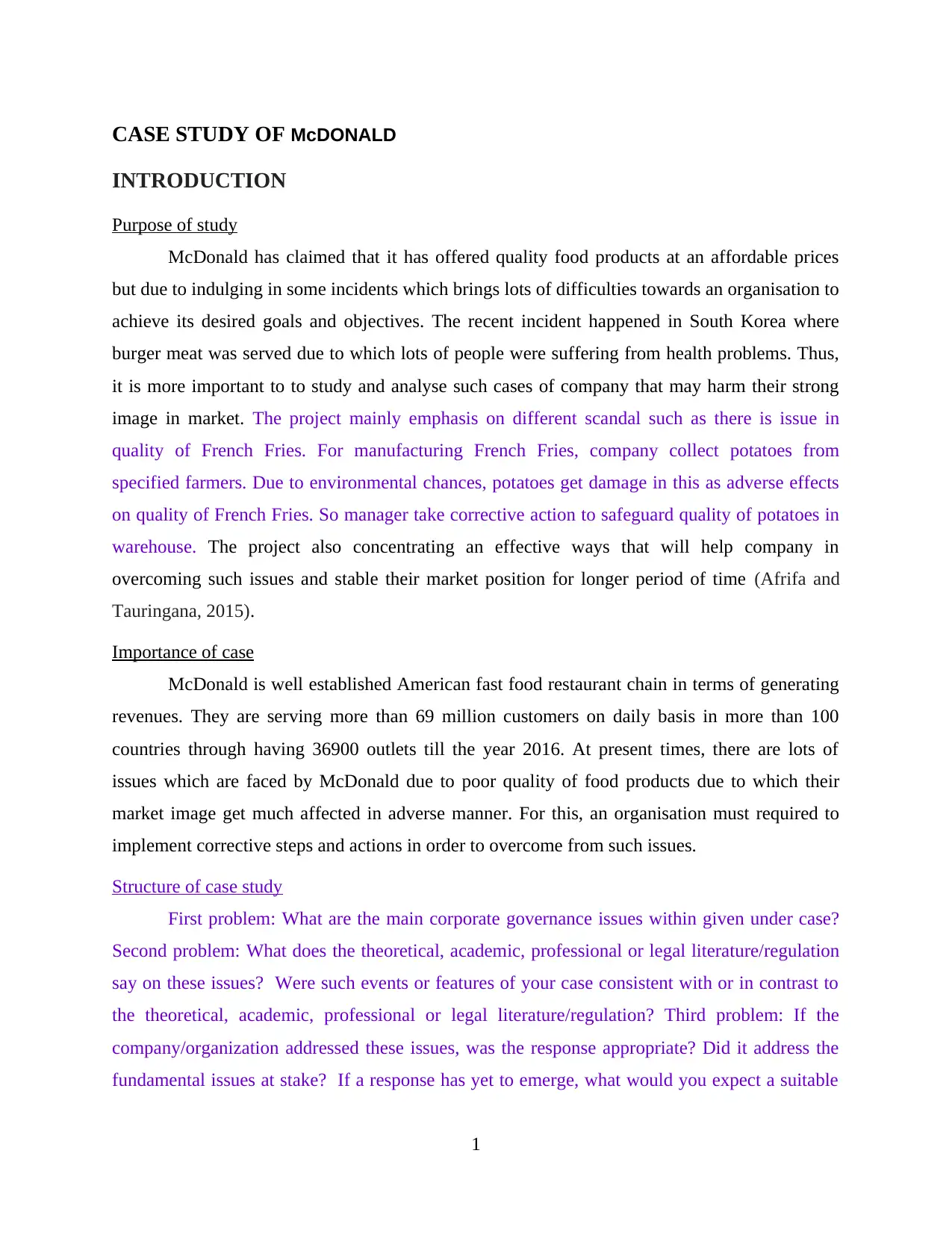
CASE STUDY OF McDONALD
INTRODUCTION
Purpose of study
McDonald has claimed that it has offered quality food products at an affordable prices
but due to indulging in some incidents which brings lots of difficulties towards an organisation to
achieve its desired goals and objectives. The recent incident happened in South Korea where
burger meat was served due to which lots of people were suffering from health problems. Thus,
it is more important to to study and analyse such cases of company that may harm their strong
image in market. The project mainly emphasis on different scandal such as there is issue in
quality of French Fries. For manufacturing French Fries, company collect potatoes from
specified farmers. Due to environmental chances, potatoes get damage in this as adverse effects
on quality of French Fries. So manager take corrective action to safeguard quality of potatoes in
warehouse. The project also concentrating an effective ways that will help company in
overcoming such issues and stable their market position for longer period of time (Afrifa and
Tauringana, 2015).
Importance of case
McDonald is well established American fast food restaurant chain in terms of generating
revenues. They are serving more than 69 million customers on daily basis in more than 100
countries through having 36900 outlets till the year 2016. At present times, there are lots of
issues which are faced by McDonald due to poor quality of food products due to which their
market image get much affected in adverse manner. For this, an organisation must required to
implement corrective steps and actions in order to overcome from such issues.
Structure of case study
First problem: What are the main corporate governance issues within given under case?
Second problem: What does the theoretical, academic, professional or legal literature/regulation
say on these issues? Were such events or features of your case consistent with or in contrast to
the theoretical, academic, professional or legal literature/regulation? Third problem: If the
company/organization addressed these issues, was the response appropriate? Did it address the
fundamental issues at stake? If a response has yet to emerge, what would you expect a suitable
1
INTRODUCTION
Purpose of study
McDonald has claimed that it has offered quality food products at an affordable prices
but due to indulging in some incidents which brings lots of difficulties towards an organisation to
achieve its desired goals and objectives. The recent incident happened in South Korea where
burger meat was served due to which lots of people were suffering from health problems. Thus,
it is more important to to study and analyse such cases of company that may harm their strong
image in market. The project mainly emphasis on different scandal such as there is issue in
quality of French Fries. For manufacturing French Fries, company collect potatoes from
specified farmers. Due to environmental chances, potatoes get damage in this as adverse effects
on quality of French Fries. So manager take corrective action to safeguard quality of potatoes in
warehouse. The project also concentrating an effective ways that will help company in
overcoming such issues and stable their market position for longer period of time (Afrifa and
Tauringana, 2015).
Importance of case
McDonald is well established American fast food restaurant chain in terms of generating
revenues. They are serving more than 69 million customers on daily basis in more than 100
countries through having 36900 outlets till the year 2016. At present times, there are lots of
issues which are faced by McDonald due to poor quality of food products due to which their
market image get much affected in adverse manner. For this, an organisation must required to
implement corrective steps and actions in order to overcome from such issues.
Structure of case study
First problem: What are the main corporate governance issues within given under case?
Second problem: What does the theoretical, academic, professional or legal literature/regulation
say on these issues? Were such events or features of your case consistent with or in contrast to
the theoretical, academic, professional or legal literature/regulation? Third problem: If the
company/organization addressed these issues, was the response appropriate? Did it address the
fundamental issues at stake? If a response has yet to emerge, what would you expect a suitable
1
Paraphrase This Document
Need a fresh take? Get an instant paraphrase of this document with our AI Paraphraser
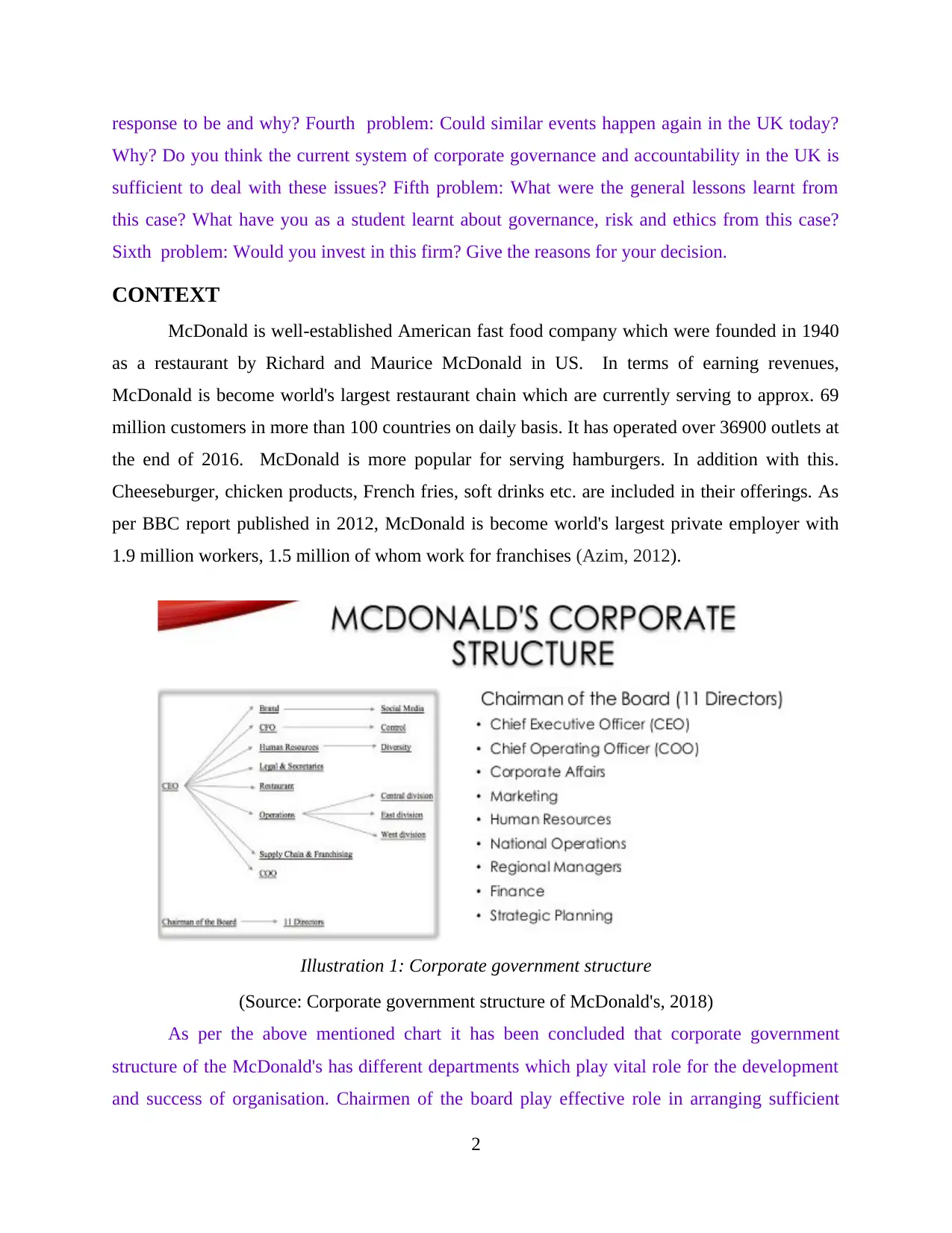
response to be and why? Fourth problem: Could similar events happen again in the UK today?
Why? Do you think the current system of corporate governance and accountability in the UK is
sufficient to deal with these issues? Fifth problem: What were the general lessons learnt from
this case? What have you as a student learnt about governance, risk and ethics from this case?
Sixth problem: Would you invest in this firm? Give the reasons for your decision.
CONTEXT
McDonald is well-established American fast food company which were founded in 1940
as a restaurant by Richard and Maurice McDonald in US. In terms of earning revenues,
McDonald is become world's largest restaurant chain which are currently serving to approx. 69
million customers in more than 100 countries on daily basis. It has operated over 36900 outlets at
the end of 2016. McDonald is more popular for serving hamburgers. In addition with this.
Cheeseburger, chicken products, French fries, soft drinks etc. are included in their offerings. As
per BBC report published in 2012, McDonald is become world's largest private employer with
1.9 million workers, 1.5 million of whom work for franchises (Azim, 2012).
(Source: Corporate government structure of McDonald's, 2018)
As per the above mentioned chart it has been concluded that corporate government
structure of the McDonald's has different departments which play vital role for the development
and success of organisation. Chairmen of the board play effective role in arranging sufficient
2
Illustration 1: Corporate government structure
Why? Do you think the current system of corporate governance and accountability in the UK is
sufficient to deal with these issues? Fifth problem: What were the general lessons learnt from
this case? What have you as a student learnt about governance, risk and ethics from this case?
Sixth problem: Would you invest in this firm? Give the reasons for your decision.
CONTEXT
McDonald is well-established American fast food company which were founded in 1940
as a restaurant by Richard and Maurice McDonald in US. In terms of earning revenues,
McDonald is become world's largest restaurant chain which are currently serving to approx. 69
million customers in more than 100 countries on daily basis. It has operated over 36900 outlets at
the end of 2016. McDonald is more popular for serving hamburgers. In addition with this.
Cheeseburger, chicken products, French fries, soft drinks etc. are included in their offerings. As
per BBC report published in 2012, McDonald is become world's largest private employer with
1.9 million workers, 1.5 million of whom work for franchises (Azim, 2012).
(Source: Corporate government structure of McDonald's, 2018)
As per the above mentioned chart it has been concluded that corporate government
structure of the McDonald's has different departments which play vital role for the development
and success of organisation. Chairmen of the board play effective role in arranging sufficient
2
Illustration 1: Corporate government structure

amount of money for maintaining daily basis transaction appropriately. Corporation's Board of
director of McDonald's is entrusted with and liable for the oversight of business affairs and assets
of company in a fair, honest, ethical and diligent manner. This board has more believed that good
corporate governance is a journey not a location. Therefore, they are committed to reviewing
their governance principles or values at least annually with an opinion ti continuous
improvements.
The incidents or issues arising within an organisation will be successfully analyse with
the help of its corporate governance structure.
The corporate governance structure is considered as most important and applicable by an
organisation such as McDonald in order to achieve desired objectives.
Above mentioned picture demonstrates the corporate governance structure of McDonald.
There are majorly four issues faced by McDonald have been spotted out within the case study
which enable management of McDonald to analyse and take further corrective actions to resolve.
Description of Key Events
Scenario 1: This case is related with contaminated food which negatively affects the
health of customers. In this case, an incident had occurred in South Korea where the customers
consume budget meat served by McDonald and after which lots of customers are founded
unhealthy. Out of such customers, one child has found which was suffering heavily due to which
her mother claimed that her child has suffered permanent kidney failure. Apart from this, there
are other incidents as well related with poor quality food products. This all incidents has
negatively impact on the strong image of McDonald in competitive market. In the context of
such issue, the Decision making theory is required to be applied on the basis of which McDonald
has mainly focuses on improving the process of producing quality food products. It enable an
organization to re-attain their strong image in competitive market (Blanchard and Peale, 2011).
Scenario 2: This is the another case which were happened in 1990 related with French
Fries. McDonald has claimed that they have using vegetable oil in cooking French fries but later
on, it has been found after raising voice by some customers that company has uses beef oil in
process of cooking food products. Due to this, the court implement strict actions against the
company. The law suit ended in 2002 resulting McDonald had make payment of $10 million
dollars as a penalty. This case is related with misrepresentation due to which the company had
faces huge loss in their profits and customer base as well. Along with this, brand image of
3
director of McDonald's is entrusted with and liable for the oversight of business affairs and assets
of company in a fair, honest, ethical and diligent manner. This board has more believed that good
corporate governance is a journey not a location. Therefore, they are committed to reviewing
their governance principles or values at least annually with an opinion ti continuous
improvements.
The incidents or issues arising within an organisation will be successfully analyse with
the help of its corporate governance structure.
The corporate governance structure is considered as most important and applicable by an
organisation such as McDonald in order to achieve desired objectives.
Above mentioned picture demonstrates the corporate governance structure of McDonald.
There are majorly four issues faced by McDonald have been spotted out within the case study
which enable management of McDonald to analyse and take further corrective actions to resolve.
Description of Key Events
Scenario 1: This case is related with contaminated food which negatively affects the
health of customers. In this case, an incident had occurred in South Korea where the customers
consume budget meat served by McDonald and after which lots of customers are founded
unhealthy. Out of such customers, one child has found which was suffering heavily due to which
her mother claimed that her child has suffered permanent kidney failure. Apart from this, there
are other incidents as well related with poor quality food products. This all incidents has
negatively impact on the strong image of McDonald in competitive market. In the context of
such issue, the Decision making theory is required to be applied on the basis of which McDonald
has mainly focuses on improving the process of producing quality food products. It enable an
organization to re-attain their strong image in competitive market (Blanchard and Peale, 2011).
Scenario 2: This is the another case which were happened in 1990 related with French
Fries. McDonald has claimed that they have using vegetable oil in cooking French fries but later
on, it has been found after raising voice by some customers that company has uses beef oil in
process of cooking food products. Due to this, the court implement strict actions against the
company. The law suit ended in 2002 resulting McDonald had make payment of $10 million
dollars as a penalty. This case is related with misrepresentation due to which the company had
faces huge loss in their profits and customer base as well. Along with this, brand image of
3
⊘ This is a preview!⊘
Do you want full access?
Subscribe today to unlock all pages.

Trusted by 1+ million students worldwide
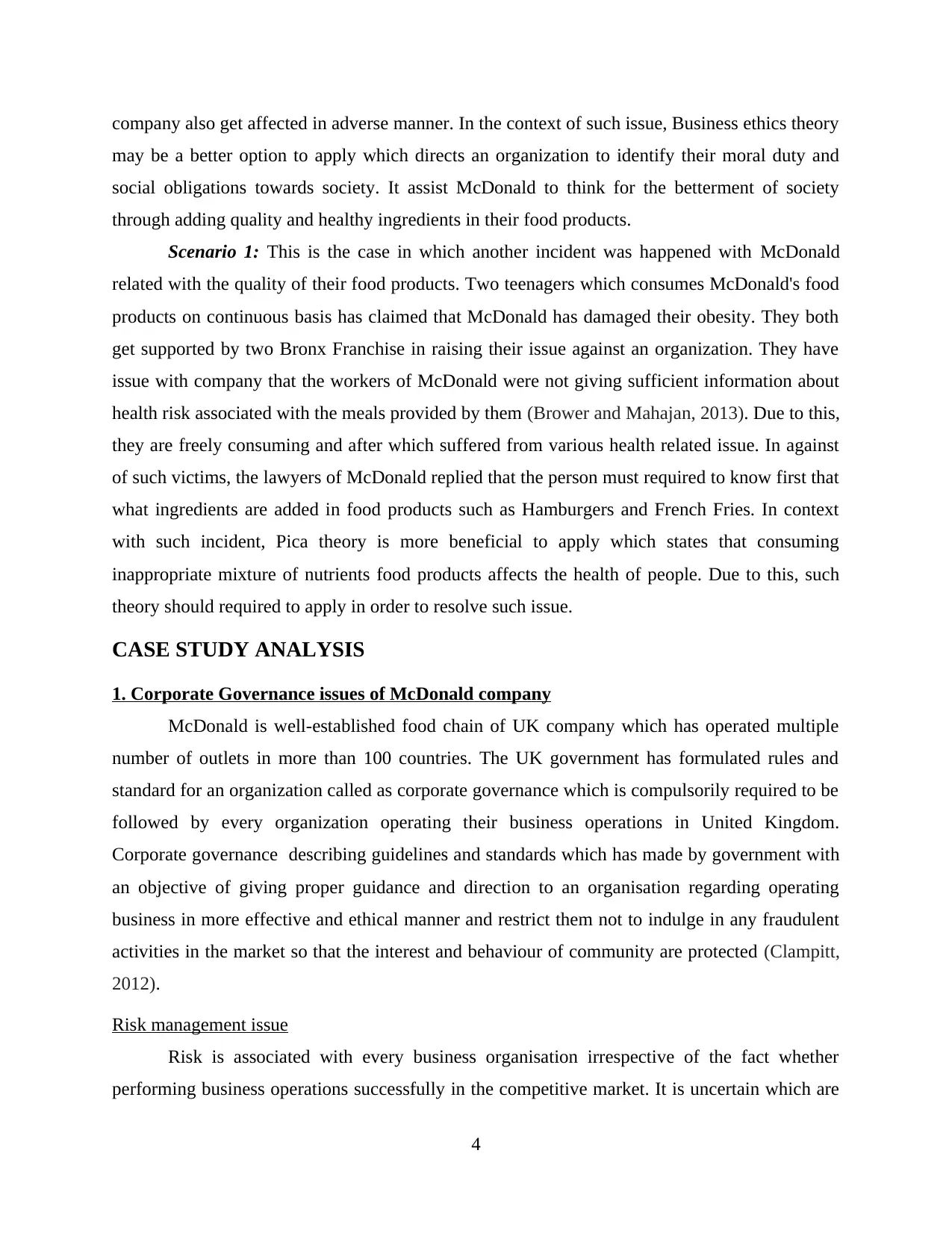
company also get affected in adverse manner. In the context of such issue, Business ethics theory
may be a better option to apply which directs an organization to identify their moral duty and
social obligations towards society. It assist McDonald to think for the betterment of society
through adding quality and healthy ingredients in their food products.
Scenario 1: This is the case in which another incident was happened with McDonald
related with the quality of their food products. Two teenagers which consumes McDonald's food
products on continuous basis has claimed that McDonald has damaged their obesity. They both
get supported by two Bronx Franchise in raising their issue against an organization. They have
issue with company that the workers of McDonald were not giving sufficient information about
health risk associated with the meals provided by them (Brower and Mahajan, 2013). Due to this,
they are freely consuming and after which suffered from various health related issue. In against
of such victims, the lawyers of McDonald replied that the person must required to know first that
what ingredients are added in food products such as Hamburgers and French Fries. In context
with such incident, Pica theory is more beneficial to apply which states that consuming
inappropriate mixture of nutrients food products affects the health of people. Due to this, such
theory should required to apply in order to resolve such issue.
CASE STUDY ANALYSIS
1. Corporate Governance issues of McDonald company
McDonald is well-established food chain of UK company which has operated multiple
number of outlets in more than 100 countries. The UK government has formulated rules and
standard for an organization called as corporate governance which is compulsorily required to be
followed by every organization operating their business operations in United Kingdom.
Corporate governance describing guidelines and standards which has made by government with
an objective of giving proper guidance and direction to an organisation regarding operating
business in more effective and ethical manner and restrict them not to indulge in any fraudulent
activities in the market so that the interest and behaviour of community are protected (Clampitt,
2012).
Risk management issue
Risk is associated with every business organisation irrespective of the fact whether
performing business operations successfully in the competitive market. It is uncertain which are
4
may be a better option to apply which directs an organization to identify their moral duty and
social obligations towards society. It assist McDonald to think for the betterment of society
through adding quality and healthy ingredients in their food products.
Scenario 1: This is the case in which another incident was happened with McDonald
related with the quality of their food products. Two teenagers which consumes McDonald's food
products on continuous basis has claimed that McDonald has damaged their obesity. They both
get supported by two Bronx Franchise in raising their issue against an organization. They have
issue with company that the workers of McDonald were not giving sufficient information about
health risk associated with the meals provided by them (Brower and Mahajan, 2013). Due to this,
they are freely consuming and after which suffered from various health related issue. In against
of such victims, the lawyers of McDonald replied that the person must required to know first that
what ingredients are added in food products such as Hamburgers and French Fries. In context
with such incident, Pica theory is more beneficial to apply which states that consuming
inappropriate mixture of nutrients food products affects the health of people. Due to this, such
theory should required to apply in order to resolve such issue.
CASE STUDY ANALYSIS
1. Corporate Governance issues of McDonald company
McDonald is well-established food chain of UK company which has operated multiple
number of outlets in more than 100 countries. The UK government has formulated rules and
standard for an organization called as corporate governance which is compulsorily required to be
followed by every organization operating their business operations in United Kingdom.
Corporate governance describing guidelines and standards which has made by government with
an objective of giving proper guidance and direction to an organisation regarding operating
business in more effective and ethical manner and restrict them not to indulge in any fraudulent
activities in the market so that the interest and behaviour of community are protected (Clampitt,
2012).
Risk management issue
Risk is associated with every business organisation irrespective of the fact whether
performing business operations successfully in the competitive market. It is uncertain which are
4
Paraphrase This Document
Need a fresh take? Get an instant paraphrase of this document with our AI Paraphraser
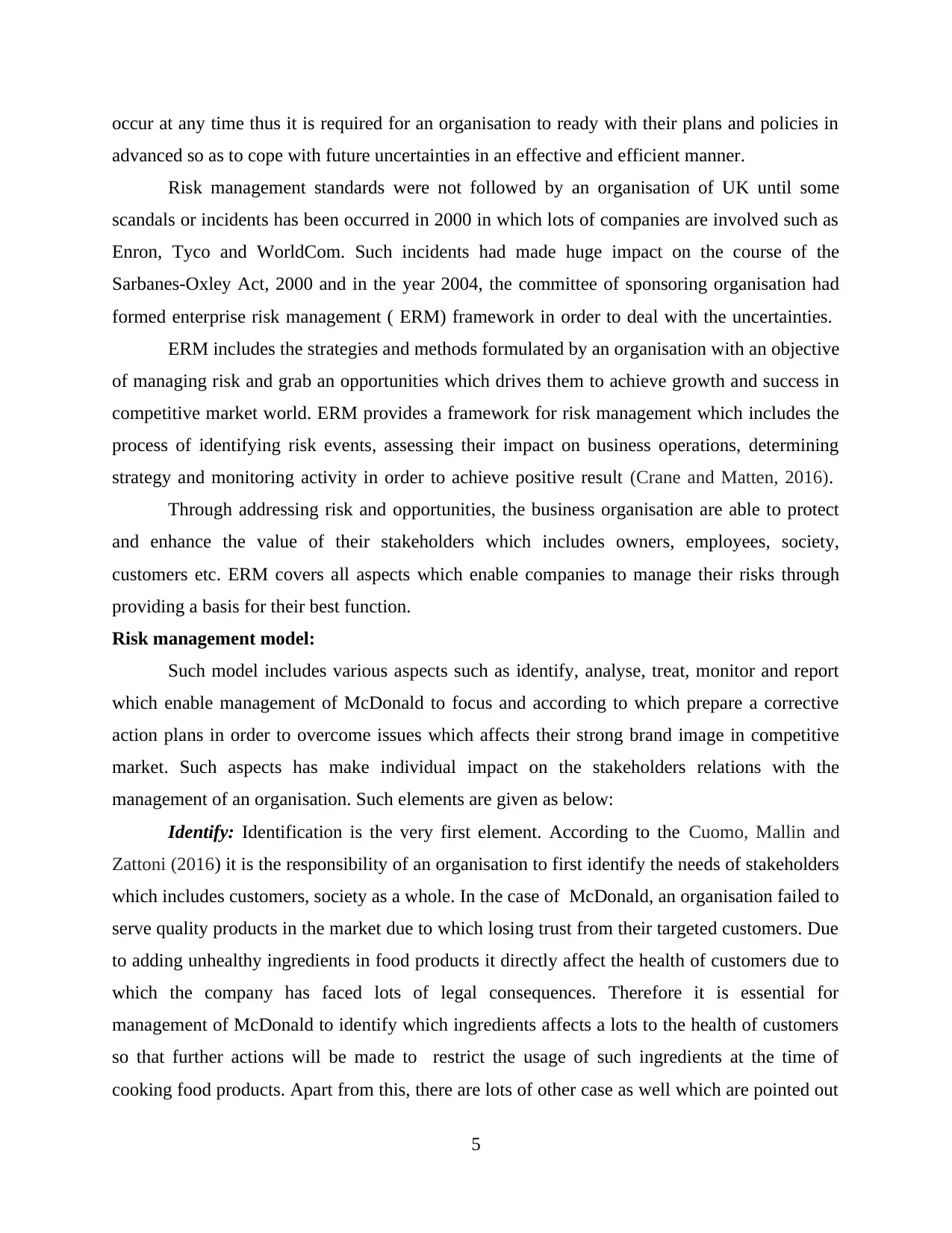
occur at any time thus it is required for an organisation to ready with their plans and policies in
advanced so as to cope with future uncertainties in an effective and efficient manner.
Risk management standards were not followed by an organisation of UK until some
scandals or incidents has been occurred in 2000 in which lots of companies are involved such as
Enron, Tyco and WorldCom. Such incidents had made huge impact on the course of the
Sarbanes-Oxley Act, 2000 and in the year 2004, the committee of sponsoring organisation had
formed enterprise risk management ( ERM) framework in order to deal with the uncertainties.
ERM includes the strategies and methods formulated by an organisation with an objective
of managing risk and grab an opportunities which drives them to achieve growth and success in
competitive market world. ERM provides a framework for risk management which includes the
process of identifying risk events, assessing their impact on business operations, determining
strategy and monitoring activity in order to achieve positive result (Crane and Matten, 2016).
Through addressing risk and opportunities, the business organisation are able to protect
and enhance the value of their stakeholders which includes owners, employees, society,
customers etc. ERM covers all aspects which enable companies to manage their risks through
providing a basis for their best function.
Risk management model:
Such model includes various aspects such as identify, analyse, treat, monitor and report
which enable management of McDonald to focus and according to which prepare a corrective
action plans in order to overcome issues which affects their strong brand image in competitive
market. Such aspects has make individual impact on the stakeholders relations with the
management of an organisation. Such elements are given as below:
Identify: Identification is the very first element. According to the Cuomo, Mallin and
Zattoni (2016) it is the responsibility of an organisation to first identify the needs of stakeholders
which includes customers, society as a whole. In the case of McDonald, an organisation failed to
serve quality products in the market due to which losing trust from their targeted customers. Due
to adding unhealthy ingredients in food products it directly affect the health of customers due to
which the company has faced lots of legal consequences. Therefore it is essential for
management of McDonald to identify which ingredients affects a lots to the health of customers
so that further actions will be made to restrict the usage of such ingredients at the time of
cooking food products. Apart from this, there are lots of other case as well which are pointed out
5
advanced so as to cope with future uncertainties in an effective and efficient manner.
Risk management standards were not followed by an organisation of UK until some
scandals or incidents has been occurred in 2000 in which lots of companies are involved such as
Enron, Tyco and WorldCom. Such incidents had made huge impact on the course of the
Sarbanes-Oxley Act, 2000 and in the year 2004, the committee of sponsoring organisation had
formed enterprise risk management ( ERM) framework in order to deal with the uncertainties.
ERM includes the strategies and methods formulated by an organisation with an objective
of managing risk and grab an opportunities which drives them to achieve growth and success in
competitive market world. ERM provides a framework for risk management which includes the
process of identifying risk events, assessing their impact on business operations, determining
strategy and monitoring activity in order to achieve positive result (Crane and Matten, 2016).
Through addressing risk and opportunities, the business organisation are able to protect
and enhance the value of their stakeholders which includes owners, employees, society,
customers etc. ERM covers all aspects which enable companies to manage their risks through
providing a basis for their best function.
Risk management model:
Such model includes various aspects such as identify, analyse, treat, monitor and report
which enable management of McDonald to focus and according to which prepare a corrective
action plans in order to overcome issues which affects their strong brand image in competitive
market. Such aspects has make individual impact on the stakeholders relations with the
management of an organisation. Such elements are given as below:
Identify: Identification is the very first element. According to the Cuomo, Mallin and
Zattoni (2016) it is the responsibility of an organisation to first identify the needs of stakeholders
which includes customers, society as a whole. In the case of McDonald, an organisation failed to
serve quality products in the market due to which losing trust from their targeted customers. Due
to adding unhealthy ingredients in food products it directly affect the health of customers due to
which the company has faced lots of legal consequences. Therefore it is essential for
management of McDonald to identify which ingredients affects a lots to the health of customers
so that further actions will be made to restrict the usage of such ingredients at the time of
cooking food products. Apart from this, there are lots of other case as well which are pointed out
5

earlier which requires proper strategies and plans to resolve as soon as possible so as to protect
band image in market.
Analyse: It is the key factor which help in understanding the preferences and priorities of
stakeholders' needs and requirements. According to the Dawson and Grill (2012)an organisation
must required to focus on enhancing the satisfaction level through offering them quality food
products which affects their customer's health in positive manner. For this, the management must
required to first analyse the impact of ingredients used in producing food products and according
to which make decisions regarding adding or removing particular ingredients in the production
process. Therefore, McDonald should always give their maximum efforts in acquiring latest
equipments and injected healthy ingredients in their fast food products. McDonald if failed to
maximise the satisfaction level of targeted customers and recognized the priority of needs of
their stakeholders then it has faces the own risks.
Treat: According to the Devinney, Schwalbach and Williams (2013)an organisation must
required to prepare suitable plans and policies in order to treat their stakeholder in an effective
and efficient manner. Therefore there is need for McDonald to focus on such factor which help
in maximising the satisfaction level of customers through giving them better treatment by
offering quality foods and services at their outlets. If McDonald failed to pay attention on its
stakeholders and continuing to provide food products contain harmful contaminants then the
same actions are also be observed from the side of stakeholders.
Monitor: According to the Gordon (2015) an organisation must required to monitor the
process of producing food products and eliminate such harmful ingredients so that the health and
lifestyle of their targeted customers are not get affected. As discussed under second case, it has
found that the company has using beef oil and communicate people about using vegetable oil due
to which the trust and loyalty of customers are much get affected. For this, the affected
customers raised their voice against an organisation which harm the strong image of McDonald
among their rivals. Therefore, to re-attain the confidence of their targeted customers, the
management of an organisation must required to consider their views and feedbacks according to
which corrective action will be made.
Report: The last aspect of risk management model is the report in which the
communication has been made between an organisation and stakeholders. Hartman, DesJardins
and MacDonald (2011) stated that identification of problems and minimises the risk in near
6
band image in market.
Analyse: It is the key factor which help in understanding the preferences and priorities of
stakeholders' needs and requirements. According to the Dawson and Grill (2012)an organisation
must required to focus on enhancing the satisfaction level through offering them quality food
products which affects their customer's health in positive manner. For this, the management must
required to first analyse the impact of ingredients used in producing food products and according
to which make decisions regarding adding or removing particular ingredients in the production
process. Therefore, McDonald should always give their maximum efforts in acquiring latest
equipments and injected healthy ingredients in their fast food products. McDonald if failed to
maximise the satisfaction level of targeted customers and recognized the priority of needs of
their stakeholders then it has faces the own risks.
Treat: According to the Devinney, Schwalbach and Williams (2013)an organisation must
required to prepare suitable plans and policies in order to treat their stakeholder in an effective
and efficient manner. Therefore there is need for McDonald to focus on such factor which help
in maximising the satisfaction level of customers through giving them better treatment by
offering quality foods and services at their outlets. If McDonald failed to pay attention on its
stakeholders and continuing to provide food products contain harmful contaminants then the
same actions are also be observed from the side of stakeholders.
Monitor: According to the Gordon (2015) an organisation must required to monitor the
process of producing food products and eliminate such harmful ingredients so that the health and
lifestyle of their targeted customers are not get affected. As discussed under second case, it has
found that the company has using beef oil and communicate people about using vegetable oil due
to which the trust and loyalty of customers are much get affected. For this, the affected
customers raised their voice against an organisation which harm the strong image of McDonald
among their rivals. Therefore, to re-attain the confidence of their targeted customers, the
management of an organisation must required to consider their views and feedbacks according to
which corrective action will be made.
Report: The last aspect of risk management model is the report in which the
communication has been made between an organisation and stakeholders. Hartman, DesJardins
and MacDonald (2011) stated that identification of problems and minimises the risk in near
6
⊘ This is a preview!⊘
Do you want full access?
Subscribe today to unlock all pages.

Trusted by 1+ million students worldwide
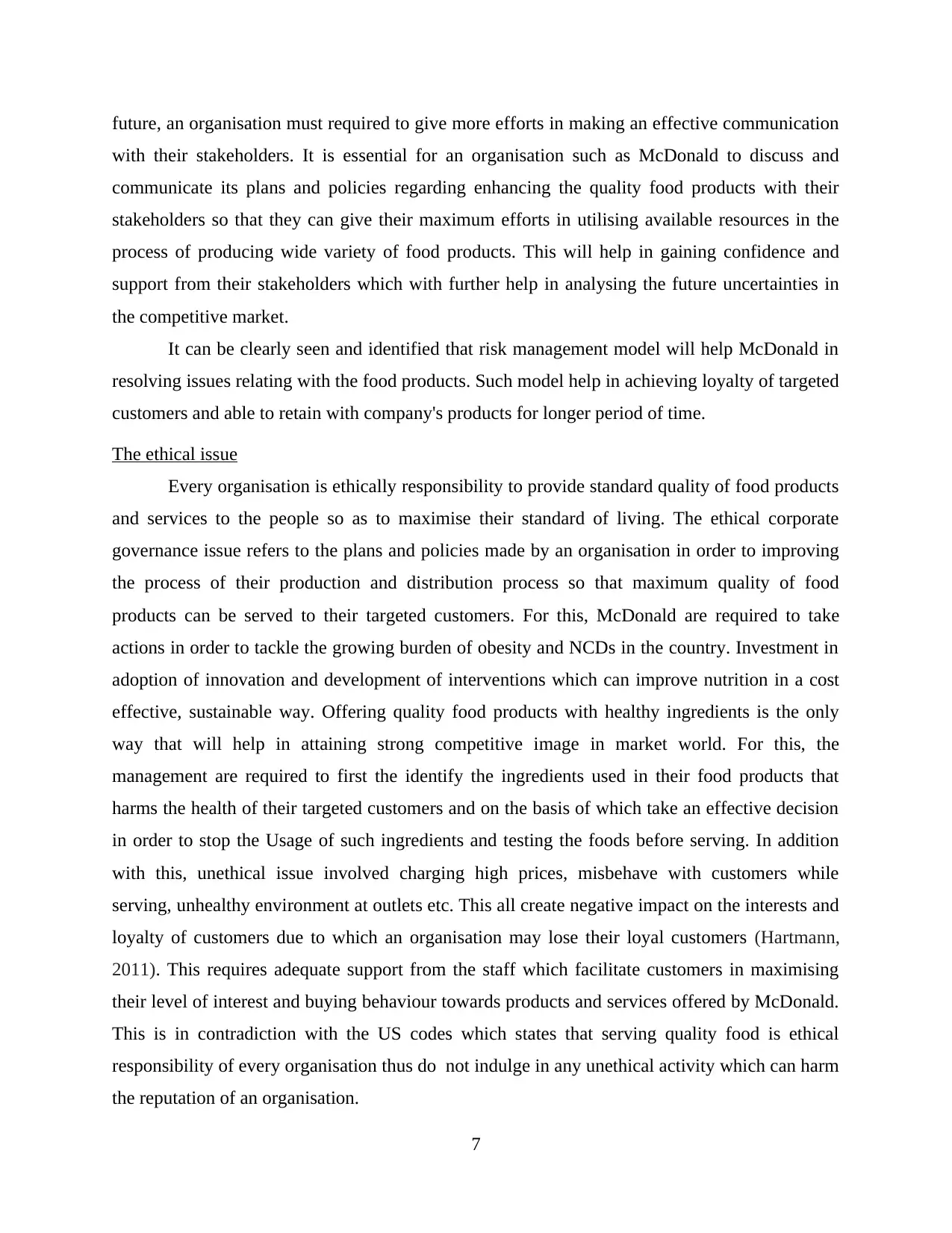
future, an organisation must required to give more efforts in making an effective communication
with their stakeholders. It is essential for an organisation such as McDonald to discuss and
communicate its plans and policies regarding enhancing the quality food products with their
stakeholders so that they can give their maximum efforts in utilising available resources in the
process of producing wide variety of food products. This will help in gaining confidence and
support from their stakeholders which with further help in analysing the future uncertainties in
the competitive market.
It can be clearly seen and identified that risk management model will help McDonald in
resolving issues relating with the food products. Such model help in achieving loyalty of targeted
customers and able to retain with company's products for longer period of time.
The ethical issue
Every organisation is ethically responsibility to provide standard quality of food products
and services to the people so as to maximise their standard of living. The ethical corporate
governance issue refers to the plans and policies made by an organisation in order to improving
the process of their production and distribution process so that maximum quality of food
products can be served to their targeted customers. For this, McDonald are required to take
actions in order to tackle the growing burden of obesity and NCDs in the country. Investment in
adoption of innovation and development of interventions which can improve nutrition in a cost
effective, sustainable way. Offering quality food products with healthy ingredients is the only
way that will help in attaining strong competitive image in market world. For this, the
management are required to first the identify the ingredients used in their food products that
harms the health of their targeted customers and on the basis of which take an effective decision
in order to stop the Usage of such ingredients and testing the foods before serving. In addition
with this, unethical issue involved charging high prices, misbehave with customers while
serving, unhealthy environment at outlets etc. This all create negative impact on the interests and
loyalty of customers due to which an organisation may lose their loyal customers (Hartmann,
2011). This requires adequate support from the staff which facilitate customers in maximising
their level of interest and buying behaviour towards products and services offered by McDonald.
This is in contradiction with the US codes which states that serving quality food is ethical
responsibility of every organisation thus do not indulge in any unethical activity which can harm
the reputation of an organisation.
7
with their stakeholders. It is essential for an organisation such as McDonald to discuss and
communicate its plans and policies regarding enhancing the quality food products with their
stakeholders so that they can give their maximum efforts in utilising available resources in the
process of producing wide variety of food products. This will help in gaining confidence and
support from their stakeholders which with further help in analysing the future uncertainties in
the competitive market.
It can be clearly seen and identified that risk management model will help McDonald in
resolving issues relating with the food products. Such model help in achieving loyalty of targeted
customers and able to retain with company's products for longer period of time.
The ethical issue
Every organisation is ethically responsibility to provide standard quality of food products
and services to the people so as to maximise their standard of living. The ethical corporate
governance issue refers to the plans and policies made by an organisation in order to improving
the process of their production and distribution process so that maximum quality of food
products can be served to their targeted customers. For this, McDonald are required to take
actions in order to tackle the growing burden of obesity and NCDs in the country. Investment in
adoption of innovation and development of interventions which can improve nutrition in a cost
effective, sustainable way. Offering quality food products with healthy ingredients is the only
way that will help in attaining strong competitive image in market world. For this, the
management are required to first the identify the ingredients used in their food products that
harms the health of their targeted customers and on the basis of which take an effective decision
in order to stop the Usage of such ingredients and testing the foods before serving. In addition
with this, unethical issue involved charging high prices, misbehave with customers while
serving, unhealthy environment at outlets etc. This all create negative impact on the interests and
loyalty of customers due to which an organisation may lose their loyal customers (Hartmann,
2011). This requires adequate support from the staff which facilitate customers in maximising
their level of interest and buying behaviour towards products and services offered by McDonald.
This is in contradiction with the US codes which states that serving quality food is ethical
responsibility of every organisation thus do not indulge in any unethical activity which can harm
the reputation of an organisation.
7
Paraphrase This Document
Need a fresh take? Get an instant paraphrase of this document with our AI Paraphraser
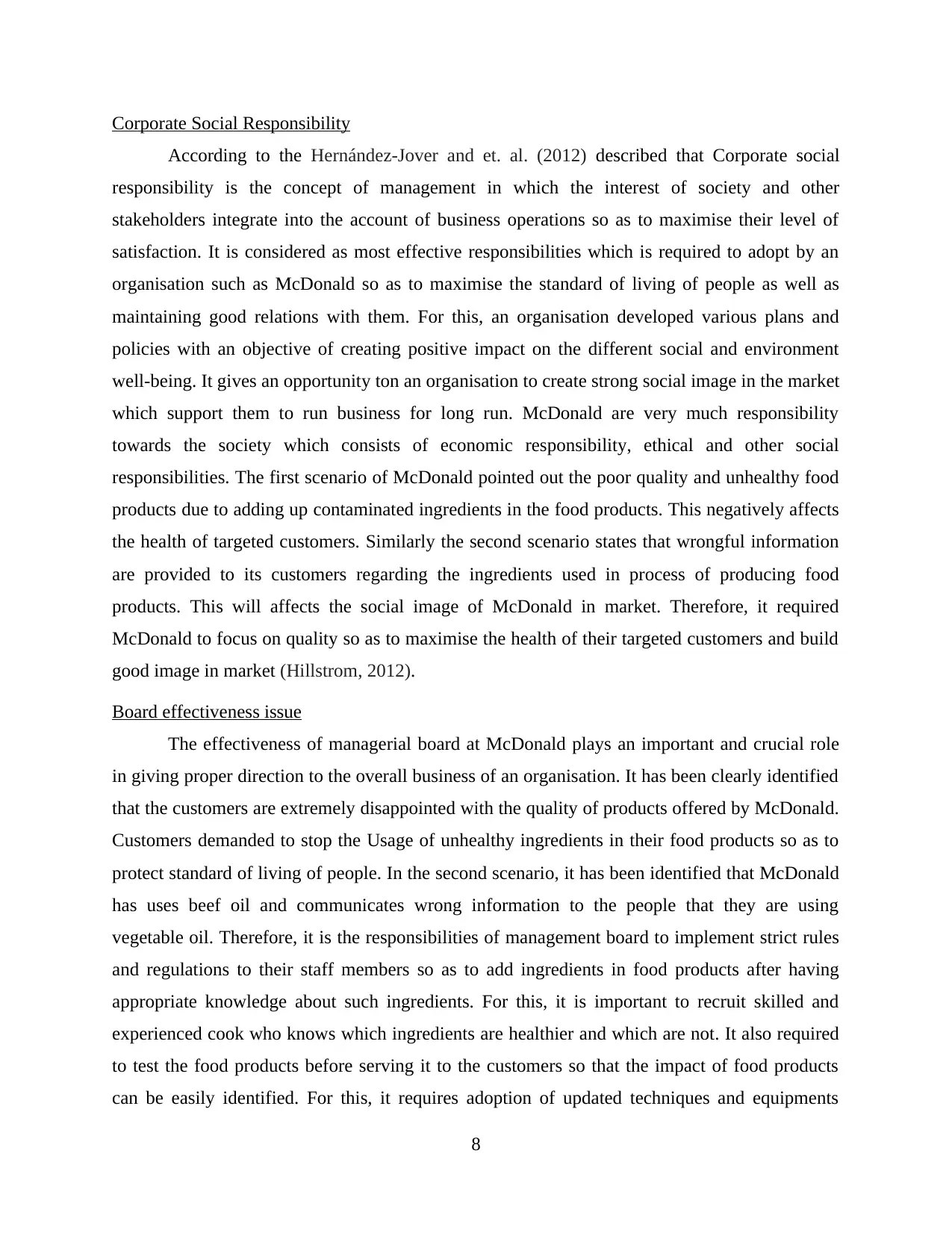
Corporate Social Responsibility
According to the Hernández-Jover and et. al. (2012) described that Corporate social
responsibility is the concept of management in which the interest of society and other
stakeholders integrate into the account of business operations so as to maximise their level of
satisfaction. It is considered as most effective responsibilities which is required to adopt by an
organisation such as McDonald so as to maximise the standard of living of people as well as
maintaining good relations with them. For this, an organisation developed various plans and
policies with an objective of creating positive impact on the different social and environment
well-being. It gives an opportunity ton an organisation to create strong social image in the market
which support them to run business for long run. McDonald are very much responsibility
towards the society which consists of economic responsibility, ethical and other social
responsibilities. The first scenario of McDonald pointed out the poor quality and unhealthy food
products due to adding up contaminated ingredients in the food products. This negatively affects
the health of targeted customers. Similarly the second scenario states that wrongful information
are provided to its customers regarding the ingredients used in process of producing food
products. This will affects the social image of McDonald in market. Therefore, it required
McDonald to focus on quality so as to maximise the health of their targeted customers and build
good image in market (Hillstrom, 2012).
Board effectiveness issue
The effectiveness of managerial board at McDonald plays an important and crucial role
in giving proper direction to the overall business of an organisation. It has been clearly identified
that the customers are extremely disappointed with the quality of products offered by McDonald.
Customers demanded to stop the Usage of unhealthy ingredients in their food products so as to
protect standard of living of people. In the second scenario, it has been identified that McDonald
has uses beef oil and communicates wrong information to the people that they are using
vegetable oil. Therefore, it is the responsibilities of management board to implement strict rules
and regulations to their staff members so as to add ingredients in food products after having
appropriate knowledge about such ingredients. For this, it is important to recruit skilled and
experienced cook who knows which ingredients are healthier and which are not. It also required
to test the food products before serving it to the customers so that the impact of food products
can be easily identified. For this, it requires adoption of updated techniques and equipments
8
According to the Hernández-Jover and et. al. (2012) described that Corporate social
responsibility is the concept of management in which the interest of society and other
stakeholders integrate into the account of business operations so as to maximise their level of
satisfaction. It is considered as most effective responsibilities which is required to adopt by an
organisation such as McDonald so as to maximise the standard of living of people as well as
maintaining good relations with them. For this, an organisation developed various plans and
policies with an objective of creating positive impact on the different social and environment
well-being. It gives an opportunity ton an organisation to create strong social image in the market
which support them to run business for long run. McDonald are very much responsibility
towards the society which consists of economic responsibility, ethical and other social
responsibilities. The first scenario of McDonald pointed out the poor quality and unhealthy food
products due to adding up contaminated ingredients in the food products. This negatively affects
the health of targeted customers. Similarly the second scenario states that wrongful information
are provided to its customers regarding the ingredients used in process of producing food
products. This will affects the social image of McDonald in market. Therefore, it required
McDonald to focus on quality so as to maximise the health of their targeted customers and build
good image in market (Hillstrom, 2012).
Board effectiveness issue
The effectiveness of managerial board at McDonald plays an important and crucial role
in giving proper direction to the overall business of an organisation. It has been clearly identified
that the customers are extremely disappointed with the quality of products offered by McDonald.
Customers demanded to stop the Usage of unhealthy ingredients in their food products so as to
protect standard of living of people. In the second scenario, it has been identified that McDonald
has uses beef oil and communicates wrong information to the people that they are using
vegetable oil. Therefore, it is the responsibilities of management board to implement strict rules
and regulations to their staff members so as to add ingredients in food products after having
appropriate knowledge about such ingredients. For this, it is important to recruit skilled and
experienced cook who knows which ingredients are healthier and which are not. It also required
to test the food products before serving it to the customers so that the impact of food products
can be easily identified. For this, it requires adoption of updated techniques and equipments
8
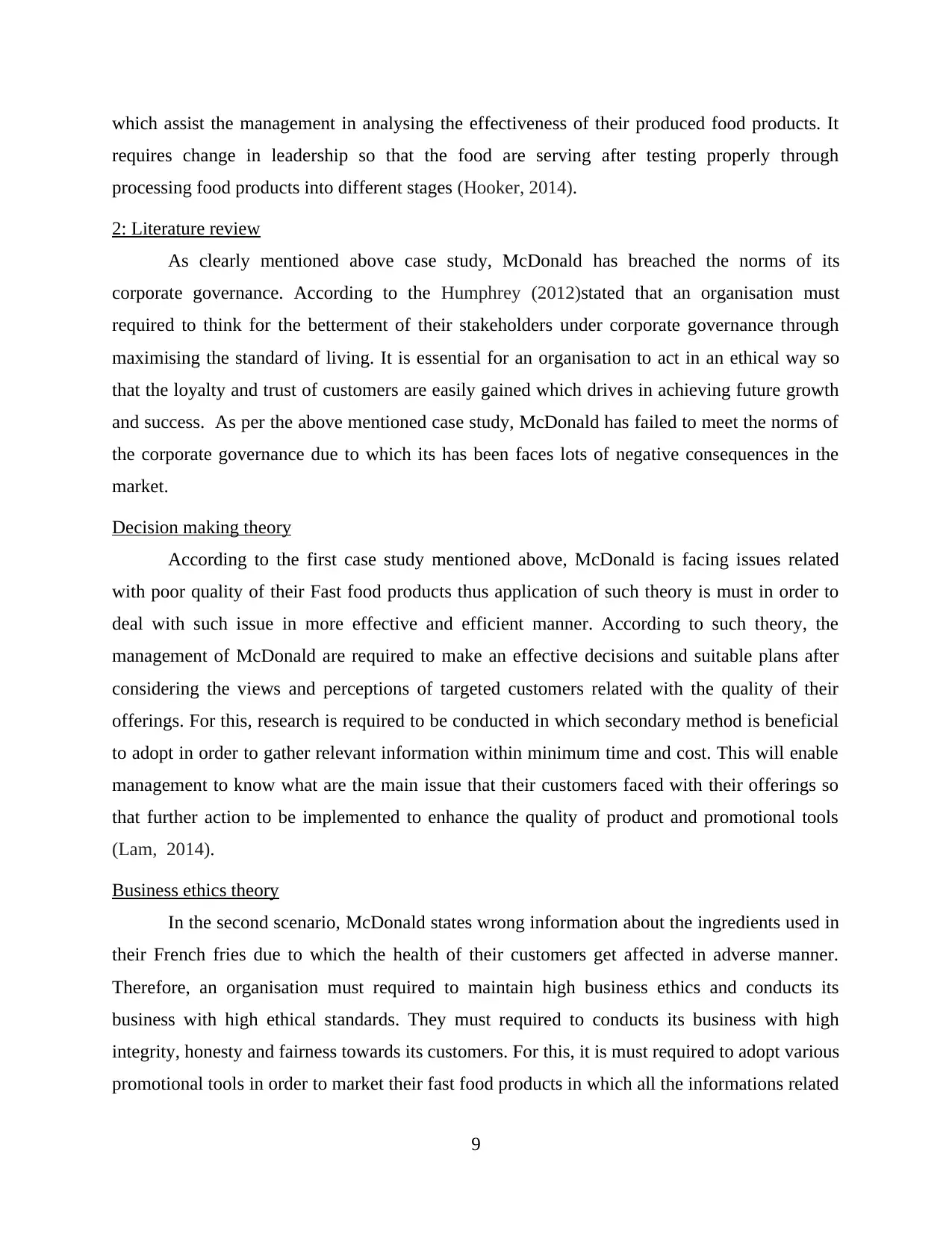
which assist the management in analysing the effectiveness of their produced food products. It
requires change in leadership so that the food are serving after testing properly through
processing food products into different stages (Hooker, 2014).
2: Literature review
As clearly mentioned above case study, McDonald has breached the norms of its
corporate governance. According to the Humphrey (2012)stated that an organisation must
required to think for the betterment of their stakeholders under corporate governance through
maximising the standard of living. It is essential for an organisation to act in an ethical way so
that the loyalty and trust of customers are easily gained which drives in achieving future growth
and success. As per the above mentioned case study, McDonald has failed to meet the norms of
the corporate governance due to which its has been faces lots of negative consequences in the
market.
Decision making theory
According to the first case study mentioned above, McDonald is facing issues related
with poor quality of their Fast food products thus application of such theory is must in order to
deal with such issue in more effective and efficient manner. According to such theory, the
management of McDonald are required to make an effective decisions and suitable plans after
considering the views and perceptions of targeted customers related with the quality of their
offerings. For this, research is required to be conducted in which secondary method is beneficial
to adopt in order to gather relevant information within minimum time and cost. This will enable
management to know what are the main issue that their customers faced with their offerings so
that further action to be implemented to enhance the quality of product and promotional tools
(Lam, 2014).
Business ethics theory
In the second scenario, McDonald states wrong information about the ingredients used in
their French fries due to which the health of their customers get affected in adverse manner.
Therefore, an organisation must required to maintain high business ethics and conducts its
business with high ethical standards. They must required to conducts its business with high
integrity, honesty and fairness towards its customers. For this, it is must required to adopt various
promotional tools in order to market their fast food products in which all the informations related
9
requires change in leadership so that the food are serving after testing properly through
processing food products into different stages (Hooker, 2014).
2: Literature review
As clearly mentioned above case study, McDonald has breached the norms of its
corporate governance. According to the Humphrey (2012)stated that an organisation must
required to think for the betterment of their stakeholders under corporate governance through
maximising the standard of living. It is essential for an organisation to act in an ethical way so
that the loyalty and trust of customers are easily gained which drives in achieving future growth
and success. As per the above mentioned case study, McDonald has failed to meet the norms of
the corporate governance due to which its has been faces lots of negative consequences in the
market.
Decision making theory
According to the first case study mentioned above, McDonald is facing issues related
with poor quality of their Fast food products thus application of such theory is must in order to
deal with such issue in more effective and efficient manner. According to such theory, the
management of McDonald are required to make an effective decisions and suitable plans after
considering the views and perceptions of targeted customers related with the quality of their
offerings. For this, research is required to be conducted in which secondary method is beneficial
to adopt in order to gather relevant information within minimum time and cost. This will enable
management to know what are the main issue that their customers faced with their offerings so
that further action to be implemented to enhance the quality of product and promotional tools
(Lam, 2014).
Business ethics theory
In the second scenario, McDonald states wrong information about the ingredients used in
their French fries due to which the health of their customers get affected in adverse manner.
Therefore, an organisation must required to maintain high business ethics and conducts its
business with high ethical standards. They must required to conducts its business with high
integrity, honesty and fairness towards its customers. For this, it is must required to adopt various
promotional tools in order to market their fast food products in which all the informations related
9
⊘ This is a preview!⊘
Do you want full access?
Subscribe today to unlock all pages.

Trusted by 1+ million students worldwide
1 out of 18
Related Documents
Your All-in-One AI-Powered Toolkit for Academic Success.
+13062052269
info@desklib.com
Available 24*7 on WhatsApp / Email
![[object Object]](/_next/static/media/star-bottom.7253800d.svg)
Unlock your academic potential
Copyright © 2020–2025 A2Z Services. All Rights Reserved. Developed and managed by ZUCOL.





